There are different types of grasshoppers found in nature. Usually, we know grasshoppers as having green color, but there are grasshoppers with different colors. In this article, we are going to talk about the brown grasshoppers and also see their spiritual meaning.
Spiritual meaning of Brown Grasshoppers?
Many things can be symbolized by a brown grasshopper. Giving up material wealth in order to connect with Mother Earth.
A brown grasshopper may also indicate that it is time to start growing close and long-term relationships, as well as to discover your roots and what you truly want.
Seeing a brown grasshopper is considered a sign of positivity and new beginnings, and usually, people consider seeing a brown grasshopper as a sign of incoming wealth.
15 Different Types Of Brown Grasshoppers
1) Rufous Grasshopper
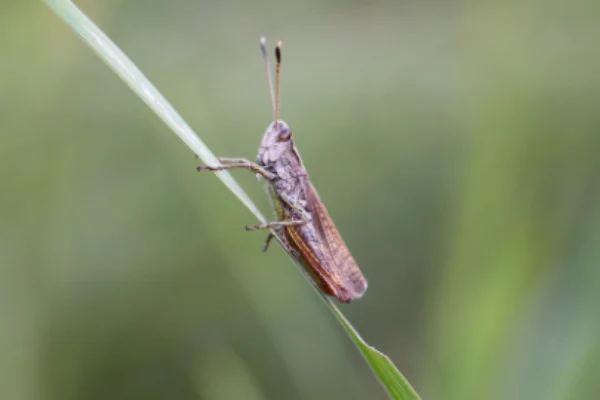
| Scientific name | Gomphocerippus Rufus |
| Size | Males range from 14 to 16 mm, while females range from 17 to 22 mm |
| Location | Most of Europe |
| Identification | The coloration is usually shades of brown but features some grey, yellow, and red. |
The rufous grasshopper, scientifically known as Gomphocerippus rufus is a grasshopper species. This is a medium-sized, broad, brown, short-horned grasshopper with clubbed antennae finished in white or pale color.
Its characteristic areas are dry grassland on calcareous soils, protected valleys with scrub, and open borders of woods. This grasshopper eats grasses and other herbaceous plants. It is distinguished by its unique display.
Its color is predominantly brown, with tints of grey, yellow, and red. The mature male has an orange-red tipped abdomen. Females have comparable coloring to males, but it is considerably less clear. Some females are reddish purple in color.
2) Common Field Grasshopper
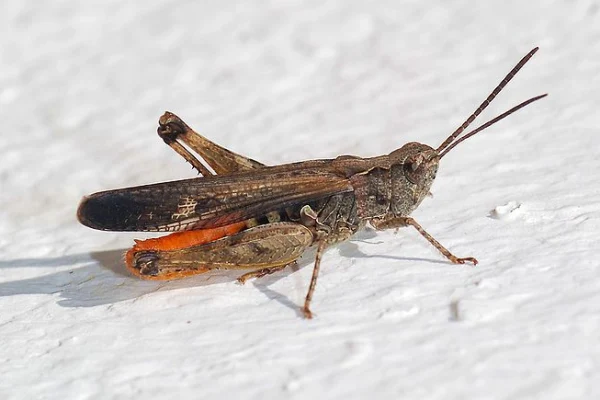
| Scientific name | Chorthippus brunneus |
| Size | 15-25 mm |
| Location | Worldwide |
| Identification | This grasshopper has a brown body and a shade of red or orange on its tail. |
Chorthippus brunneus is another name for the common field grasshopper. They are primarily brown. However, they vary greatly in color and can be black, green, purple, or white. Individual wing patterns might be colored, striped, or plain.
Green and purple grasshoppers have plain forewing patterns, whereas black grasshoppers have variegated forewing patterns. Brown grasshoppers show different forewing patterns rather than a uniform forewing pattern.
3) Ponderosus Spur-throated Grasshopper
| Scientific name | Melanoplus ponderosus |
| Size | 5cm |
| Location | North America |
| Identification | This brown grasshopper has a patterns of white color on their legs and body. |
Spur-throated grasshopper, scientifically known as Melanoplus ponderosus, is a big grasshopper genus. They are big grasshoppers that are common in North America. Melanoplus is a herbivorous species that eats all types of grasses and garden plants.
They eat the leaves, fruit, flowers, and buds, as well as the tree bark. Many of these grasshoppers are considered to be agricultural pests, particularly the Rocky Mountain locust, which is one of those Melanoplus grasshoppers which was considered to be agricultural pests but are now extinct.
This grasshopper is known for their brown coloring on the wings.
4) Brown Winter Grasshopper
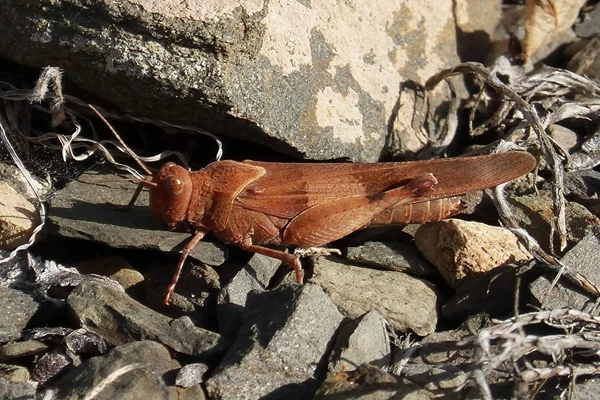
| Scientific name | Amblytropidia mysteca |
| Size | No information |
| Location | Central America and North America |
| Identification | This grasshopper has a rusty brown appearance. |
The Brown Winter Grasshopper scientifically known as Amblytropidia mysteca is an interesting insect with a brown color that matches the cool environment. Its body is usually seen with coffee brown, deep brown or sandy color.
During the winter months, the grasshopper’s brown color allows it to camouflage in the sandy area, which keeps it protected from predators, ensuring its survival throughout the season.
Furthermore, the beautiful appearance of the brown winter grasshopper is a mesmerizing insect to look at in the winter season.
5) Splender gum leaf Grasshopper
| Scientific name | Goniaea australasiae |
| Size | 50mm |
| Location | Australia |
| Identification | This grasshopper looks like a dry leaf. |
The Gumleaf Grasshopper is brown and looks like a dry gum leaf. Dead Leaf Grasshoppers are another name for them. When we go bushwalking in the Eucalyptus forest, we frequently discover them on the ground among the dry Gum tree leaves.
Adults are distinguished by a large arched crest on the thorax, which is pointed and, coupled with the color, resembles a dry gum leaf. The adult grasshopper pictured above was discovered in Mt Cotton’s gum tree woodland.
The grasshopper typically rests on the ground among dead, dried leaves. Adults are distinguished by a large arched crest on the thorax, which is pointed and, coupled with the color, resembles a dry gum leaf.
The adult grasshopper pictured above was discovered in Mt Cotton’s gum tree woodland. The grasshopper is generally found resting on dead dry leave.
6) Common Macrotona Grasshopper
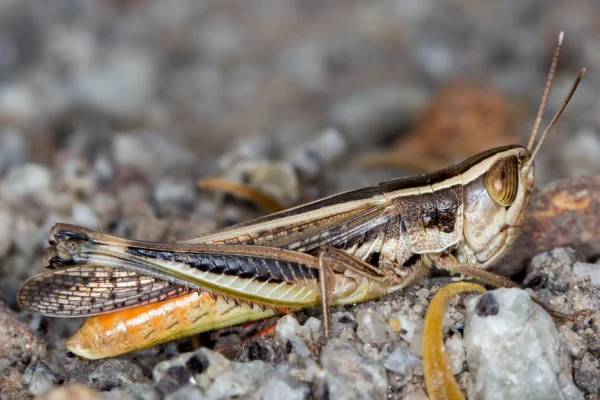
| Scientific name | Macrotona australis |
| Size | 1.7 cm – 3.0 cm |
| Location | Australia |
| Identification | This grasshopper has a dark brown body with a combination of yellow and red legs. |
The Common Macrotona Grasshopper is a member of the spur-throated grasshoppers family. The presence of a swelling on the ‘throat’ area between the front legs distinguishes spur-throated grasshoppers.
It ranges in color from red to grey. The majority of individuals, however, have a reddish bronze coloration behind the hind legs.
The Common Macrotona Grasshopper is found in New South Wales and Victoria in south-eastern Australia. They have Brown colored bodies and shades of brown on their wings, making them beautiful characters in nature.
7) Yellow-winged Grasshopper

| Scientific name | Gastrimargus musicus |
| Size | 31-46 mm |
| Location | Australia |
| Identification | This grasshopper is known for its yellow wings as the name suggests and has a brown body. |
The yellow-winged locust or yellow-winged grasshopper, Gastrimargus musicus, is a common grasshopper in Australia. In flight, it only shows its yellow rear wings and makes a loud clicking sound.
When the adults swarm, they turn a dark brown color. The yellow winged locust is occasionally confused with the Australian plague locust (Chortoicetes terminifera), albeit the latter is “stouter and larger.” These grasshoppers are known for their bright yellow wings and brown body which helps them to hide from predators.
8) Valley Grasshopper
| Scientific name | Oedaleonotus enigma |
| Size | 11.7 mm |
| Location | No Information |
| Identification | This is a light brown color body and sometimes give a look of yellow shade. |
The adult spur-throated valley grasshopper is a huge, colorful grasshopper. The valley grasshopper is predominantly a forb and shrub feeder, but it also feeds on grasses to some extent.
It has been observed feeding significantly on imported weeds, which are frequently abundant in its habitat. Redstem filaree, tumble mustard, draba mustard, pepperweed, and downy brome are among them.
It also eats a lot of lichens. These grasshoppers are known for their brown appearance.
9) Short-horned Grasshopper
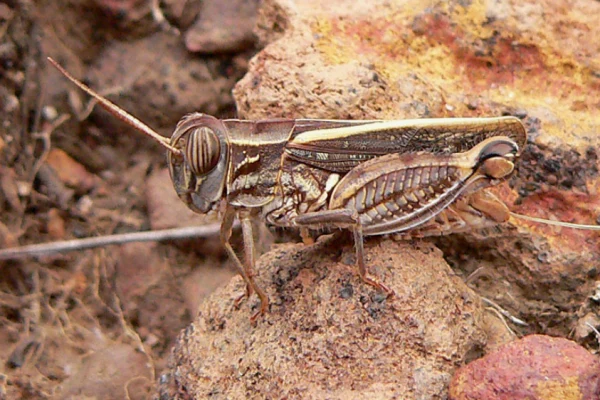
| Scientific name | Acorypha glaucopsis |
| Size | No Information |
| Location | No information |
| Identification | This is a dark brown colored grasshopper with lines following from neck to tail. |
The Short-Horned Grasshopper, scientifically known as Acorypha glaucopsis, is an interesting insect. This species stands out among grasshoppers due to its unique small antennae.
The Short-Horned Grasshopper has a small body and a remarkable blend of colors ranging from earthy browns to delicate greens, perfectly matched to its native surroundings.
These grasshoppers have amazing jumping ability because of their legs, which allow them to move quickly through grasslands and wide areas. They are herbivores and eat plants.
10) Admirable Grasshopper
| Scientific name | Syrbula admirabilis |
| Size | 1½ inches (males), to 2¼ inches (females) |
| Location | Central and North America |
| Identification | This grasshopper has a dark brown colored body. |
The Admirable Grasshopper, scientifically known as Syrbula admirabilis, is a beautiful insect with unusual characteristics. This species has a fascinating combination of shape and behavior that captivates both others and researchers.
The scientific name, Syrbula admirabilis, conveys the excitement and wonder that this grasshopper inspires in people who come into contact with it.
It blends perfectly with the lush foliage it inhabits because of its vivid green body decorated with fascinating patterns.
The capacity of the Admirable Grasshopper to make beautiful and rhythmic noises through its stridulation adds another layer of appreciation to its repertoire as it interacts with possible mates and defines its territory.
11) Orange winged Grasshopper
| Scientific name | Pardalophora phoenicoptera |
| Size | males 23-31 mm. females 30-41 mm |
| Location | Eastern United States |
| Identification | This grasshopper has a brown body and is known for its orange wings. |
The Orange-Winged Butterfly The grasshopper, scientifically known as Pardalophora phoenicoptera, is an interesting insect with a compelling appearance and activity.
This grasshopper, gets its name from the bright orange coloration of its wings and brown-colored body.
Pardalophora phoenicoptera stands out in the insect world as a symbol of beauty and grace. These grasshoppers are commonly found in arid and semi-arid environments, where they have adapted to tough environmental circumstances.
Their strong legs allow them to jump and quickly escape possible attackers. They are one of the herbivore grasshoppers.
12) Italian Grasshopper
| Scientific name | Calliptamus italicus |
| Size | Males grow up to 14–26 millimeters long, while females reach 21–40 millimetres |
| Location | Central Asia and Europe |
| Identification | This grasshop reddish-orangebrown color with a reddish orange tail. |
Calliptamus italicus, sometimes known as the Italian locust, is a species of short-horned grasshopper’ native to Western Europe and Central Asia.
It prefers warm, dry environments with limited vegetation, such as grasslands and rocky fields, ancient quarries, gravel pits, rtrewn places beside rivers, sand dunes, and fallow ground.
It prefers warm, dry environments with limited vegetation, such as grasslands and rocky steppes, ancient quarries, gravel prock-strewn places beside rivers, sand dunes, and fallow ground.Calliptamus italicus is an omnivorous species that can feed on both wild vegetation and crops.
13) Sprinkled grasshopper
| Scientific name | Chloealtis conspersa |
| Size | males is 15 mm to 20 mm, females 20 mm to 28 mm |
| Location | Northern U.S. and southern Canada, eastward from the Rocky Mountains |
| Identification | This grasshopper has a light brown body with dark brown lines on the neck and lines. |
The Sprinkled Grasshopper, scientifically known as Chloealtis conspersa, is a unique insect. This grasshopper receives its common name from the interesting pattern on its body. These grasshoppers have nice camouflage abilities that allow them to blend in smoothly.
Sprinkled grasshoppers have quick and powerful hind legs, they Sprinkled Grasshopper can jump with speed. These grasshoppers are herbivores that eat crops and play an important role in changing the environment.
Conclusion
These are the 15 different types of brown grasshoppers. They are unique in their own way. The brown grasshoppers are best known for their adaptability in their environment and the way they blend themselves in nature to protect themselves from predators.
Also Read:

I am a person who effortlessly combines creativity, hard work, and a strong interest in nature. My writing takes you on incredible journeys where science and imagination come together. I am driven by a deep curiosity to understand the wonders of life, and dive into the details of biology with thorough research and a genuine appreciation for nature. My articles are full of vivid descriptions and fascinating facts, making the world of biology come alive. Whether I am writing articles, essays, or fiction, my work sparks curiosity and shows the incredible beauty of our natural world.
